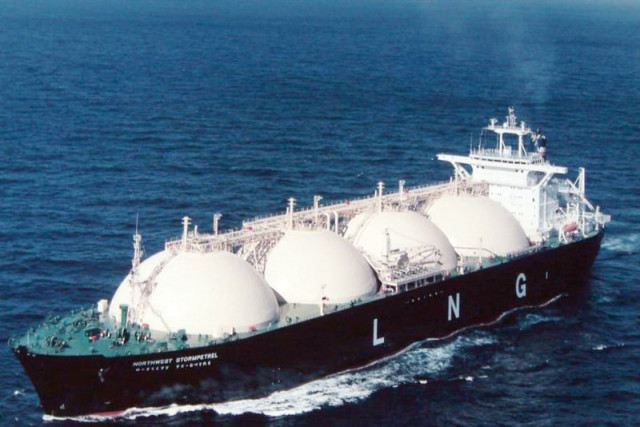Upcoming: Rs10.54 per unit tariff likely for LNG-run power plants
Regulator will take decision on Feb 23 during hearing of a petition.

The government will introduce a separate mechanism with the opening of one-month Escrow account of $34.49 million to pay for LNG import and shield it from circular debt. PHOTO: AFP
The government is likely to set the tariff for electricity generated by liquefied natural gas (LNG) at Rs10.54 per unit in response to a proposal given by the Private Power and Infrastructure Board (PPIB).
“PPIB has filed a petition with the regulator, seeking approval of tariff for LNG-based power plants. The regulator will conduct a public hearing on February 23 to take the decision,” an official told The Express Tribune.
The landed cost of LNG import from Qatar, with which negotiations are progressing well, is estimated at $12 per million British thermal units (mmbtu) because of a sharp fall in crude oil prices in the international market.
Talks with Doha are in final stages and first LNG cargo is expected to be sent by the end of current month.
Data for December 2014 show that the cost of power generated from coal was Rs4.49 per unit, high-speed diesel produced electricity for Rs19 per unit, furnace oil Rs12.38 per unit, gas Rs3.57 per unit and nuclear power Rs1.18 per unit.
According to the petition to be taken up by the National Electric Power Regulatory Authority (Nepra), the government will introduce a separate mechanism with the opening of one-month Escrow account of $34.49 million to pay for LNG import and shield it from circular debt.
During the hearing, Nepra will decide whether the $12 per mmbtu LNG price and the cost of Escrow account were justified. It will also assess 15% Internal Rate of Return and 1.35% insurance cost of the engineering, procurement and construction (EPC) contract.
The developments come in the wake of the government’s plan to replace existing furnace oil-based plants with LNG-run plants in an attempt to reduce the cost of power generation. The government desires to set up 3,600-megawatt LNG-based plants in Punjab in order to ease prolonged outages.
Just in time when Pakistan is about to start importing LNG, its prices stand sharply reduced in the global market, providing an opportunity to set up LNG-run plants.
According to officials of the Ministry of Water and Power, with an upfront tariff, the government has kept the field open for power producers. It is up to the investors to establish energy plants of whatever capacity they like, which will not create a feeling that the government is supporting a specific party or company.
Earlier, the government intended to establish three imported coal-based power plants in Punjab, but now the focus has turned to LNG.
Officials point out that two imported coal-fired plants have been replaced with LNG plants, but one coal plant in Sahiwal is still being pursued.
Since work is already under way to construct an LNG pipeline in Punjab, it will be easier to develop LNG power plants at load centres in place of coal-run plants.
Officials suggest that if LNG plants are established in areas covered by the Faisalabad Electric Supply Company (Fesco), Lahore Electric Supply Company (Lesco) and Gujranwala Electric Power Company (Gepco), the losses in the transmission system and the transportation cost will drop substantially. At present, these companies are facing a shortfall in supplies.
Apart from the LNG plants, the government is seeking the regulator’s approval for setting the upfront tariff at Rs12.57 per unit for rental power plants (RPPs) and those independent power producers (IPPs), which have been shut down.
RPPs, however, need clearance from the National Accountability Bureau (NAB). With the help of these measures, the government wants to add 1,500 megawatts to the national power grid in the upcoming summer season.
Unlike the previous instance during the PPP government, the PML-N administration will give no guarantee of capacity payments to these power plants.
Published in The Express Tribune, February 14th, 2015.
Like Business on Facebook, follow @TribuneBiz on Twitter to stay informed and join in the conversation.



















COMMENTS
Comments are moderated and generally will be posted if they are on-topic and not abusive.
For more information, please see our Comments FAQ